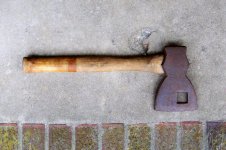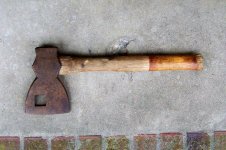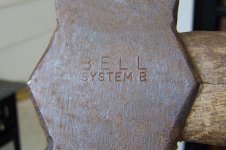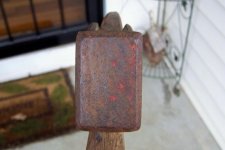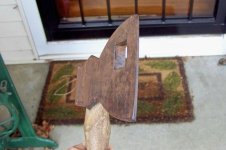What was it used for? the front edge is flat, not sharp. the hole is 1" square. the marking is BELL system B. old telephone lineman tool? got it cause I didn't have one. thanks in advance. lee
You are using an out of date browser. It may not display this or other websites correctly.
You should upgrade or use an alternative browser.
You should upgrade or use an alternative browser.
This is not a Hatchet
- Thread starter Lee Barner
- Start date
Register to hide this ad
the ringo kid
Member
- Joined
- May 12, 2013
- Messages
- 20,895
- Reaction score
- 22,820
Survey work?
bigwheelzip
Absent Comrade
STANLEY / BELL SYSTEM HATCHET
The specific years during which Stanley provided specialty hatchets for the Bell System has yet to be determined. It is believed that these hatchets were available from sometime in the 1940s until at least sometime in the 1960s. At this point no catalog reference is known extant but it is surmised they may have been provided through special orders. Also unresolved is whether Stanley provided such hatchets to other utility companies or other concerns in addition to the Bell System. Numerous examples have been observed that include a square opening cut through the hatchet blade. Such hatchets are referred to as hatchet-wrenches because the square opening accommodated the square bolt heads used to secure different apparatus to utility poles.
The hatchet-wrench was not the only axe that Stanley provided to the Bell System. Long handle single-bit axes have also been observed with both the Stanley marking and the words Bell System in what appear to be factory applied markings.
Vintage Stanley Bell System Hatchet Wrench Lineman's Tool Head In Very Good Cond
The specific years during which Stanley provided specialty hatchets for the Bell System has yet to be determined. It is believed that these hatchets were available from sometime in the 1940s until at least sometime in the 1960s. At this point no catalog reference is known extant but it is surmised they may have been provided through special orders. Also unresolved is whether Stanley provided such hatchets to other utility companies or other concerns in addition to the Bell System. Numerous examples have been observed that include a square opening cut through the hatchet blade. Such hatchets are referred to as hatchet-wrenches because the square opening accommodated the square bolt heads used to secure different apparatus to utility poles.
The hatchet-wrench was not the only axe that Stanley provided to the Bell System. Long handle single-bit axes have also been observed with both the Stanley marking and the words Bell System in what appear to be factory applied markings.
Vintage Stanley Bell System Hatchet Wrench Lineman's Tool Head In Very Good Cond
Last edited:
DWalt
Member
My guess is that the square hole probably fits a bolt head (or something similar) used on telephone poles, to tighten or loosen it. Maybe some old telephone lineman who has used one will see this and respond.
There is a number of these Stanley Bell Hatchet-Wrenches listed on eBay and similar sites, but the descriptions as to its exact purpose are all fairly vague. They must have been common.
There is a number of these Stanley Bell Hatchet-Wrenches listed on eBay and similar sites, but the descriptions as to its exact purpose are all fairly vague. They must have been common.
Last edited:
Last edited:
J. R. WEEMS
Member
Another guess here-- would have to try it to see, but one use might be to hammer in those climber steps, then use the hole as a wrench to turn it into the pole. Just guessing here.??? 
Lots of information on Google but not very definitive. Looks like it was a lineman's tool used as a hatchet, hammer and a wrench using the square hole. Back in the day many bolts and lag screws had square heads until the hex heads became popular.
There was apparently a Bell system A, B, C and maybe even D, but not much information on what the differences were.
There was apparently a Bell system A, B, C and maybe even D, but not much information on what the differences were.
SW MP15
Member
Molly Hatchet Prop???
Jack Flash
Member
I was thinking that it had never been sharpened. IE, it is in unissued condition. Note the hammer face doesn't look like it ever hit anything.Any chance those were sharp when delivered then it was later decided to grind off their edges for safety?
the ringo kid
Member
- Joined
- May 12, 2013
- Messages
- 20,895
- Reaction score
- 22,820
My guess is that the square hole probably fits a bolt head (or something similar) used on telephone poles, to tighten or loosen it. Maybe some old telephone lineman who has used one will see this and respond.
There is a number of these Stanley Bell Hatchet-Wrenches listed on eBay and similar sites, but the descriptions as to its exact purpose are all fairly vague. They must have been common.
Make sense. A multi-tool.
Cooter Brown
Member
That's really neat, Lee. Undoubtedly the poll on that hatchet is hardened.
My grandfather worked for Western Electric and my father for the Bell System.
I've got a few Bell System and Western Electric marked tools but not one of those. I do have some of the square head bolts it was made for.
Any Bell System or Western Electric tool will be of the very highest quality. Neither of those companies spared any expense when it came to sourcing tools.
Bell tools will be marked as seen in the picture. Western Elec. tools will be marked with a number preceded by the letter "R", stamped or electro-penned on the tool.
My grandfather worked for Western Electric and my father for the Bell System.
I've got a few Bell System and Western Electric marked tools but not one of those. I do have some of the square head bolts it was made for.
Any Bell System or Western Electric tool will be of the very highest quality. Neither of those companies spared any expense when it came to sourcing tools.
Bell tools will be marked as seen in the picture. Western Elec. tools will be marked with a number preceded by the letter "R", stamped or electro-penned on the tool.
My father, a telephone employee from 1949 to 1982, had one of these. The ax was dull as a hoe from the factory. The square hole fit the square nuts of what Dad always called "cross-arm bolts" which as I recall were just galvanized 3/8" carriage bolts in several lengths. He had a drawer full in his workbench. Along with the nuts and grainy galvanized washers.
Anybody have any additional thoughts on why the edge is not sharpened? (While, commonsensical, I am discounting the venture that the one in the OP was just never sharpened since above poster says his father's was dull as well.)
I speculate that whatever the chore the blade was designed for was, it did not require a sharp edge...
I speculate that whatever the chore the blade was designed for was, it did not require a sharp edge...
Dennis The B
US Veteran
My dad worked electrical construction for a number years in the early 1950's.
The "hatchet" is used to turn climbing pegs into the pole, usually several feet above ground, so people couldn't reach the bottom pegs. Up to a certain height, the lineman would use "hooks" strapped to the lower legs and boots and a special tool belt, so he could work on the pole without the foot pegs. A lot of them carried a brace and bit to start a hole in the pole, and then thread in the steel pegs, using the square hole to finish tightening the peg. The square hole was located in that position so the hatchet wouldn't fall to the ground if the lineman lost his grip while tightening the pegs.
The "hatchet" is used to turn climbing pegs into the pole, usually several feet above ground, so people couldn't reach the bottom pegs. Up to a certain height, the lineman would use "hooks" strapped to the lower legs and boots and a special tool belt, so he could work on the pole without the foot pegs. A lot of them carried a brace and bit to start a hole in the pole, and then thread in the steel pegs, using the square hole to finish tightening the peg. The square hole was located in that position so the hatchet wouldn't fall to the ground if the lineman lost his grip while tightening the pegs.
Fishslayer
US Veteran, Absent Comrade
I climbed a lot of poles putting in a telephone line.. That would have been plumb handy.. I carried a hammer for driving cross arm bolts thru the poles and a wrench for tightening the square nuts and bolts..
That would have served two purposes and saved some weight on my tool belt.
That would have served two purposes and saved some weight on my tool belt.
kthom
Member
Square heads on both bolts and nuts, plus the locking thin square nut are still the primary hardware used to attach cross arms and transformers and other equipment to utility poles today. The hatchet portion would have worked very well when removing an old cross arm by placing the hatchet edge between the round pole and the rectangular arm and prying the arm away from the pole and sliding it loose from the long bolt holding it in place. The head would have worked well to drive bolts into and out of the holes drilled in the pole and cross arm. This hatchet would have served the purpose of a hammer, a wrench for the bolts and nuts, and a pry bar, together all of which would have made a much bigger load to carry while climbing up that pole to get to the crossarm(s). Toting my butt up a pole plus the climbing gear and tool belt was a plenty big enough load without carrying all those tools. I'd have been glad to carry one tool to do the job of three or more! These tools were not available when I was doing this kind of work, but I knew a couple of old telephone linemen who had them and you'd better not be handling their tool without permission. They were not for sale or trade!
model70hunter
Member
42 years as a phone guy.
I started in 1970 as a lineman. We had 2 lb hammers and a lag wrench to drive in steps, lag screws and lag bolts. Usually had a cresent wrench to hold the nut on the bolts.
Why is the axe not sharp? My guess is safety, some one in purchasing saw the wonderment in owning the swiss knife for the phone company. They probably ordered a million and was fired after 987 folks hit their forehead with the sharp part of the axe when driving in a lag screw or step. When a lineman was in a hurry or on a dark stormy night accidently tried to drive a lag screw or step, with the sharp end and losing a digit?
Can you imagine the safety committee discussing the guys that just whacked off a thumb or finger while trying to drive a round step with a sharp blade? Nope we can't give them the correct tool, too expensive to change out.
How about just grinding the edge off the hatchet? Then thumbs won't get lopped off, only broken and they'll probably not do it a 2nd time.
I started in 1970 as a lineman. We had 2 lb hammers and a lag wrench to drive in steps, lag screws and lag bolts. Usually had a cresent wrench to hold the nut on the bolts.
Why is the axe not sharp? My guess is safety, some one in purchasing saw the wonderment in owning the swiss knife for the phone company. They probably ordered a million and was fired after 987 folks hit their forehead with the sharp part of the axe when driving in a lag screw or step. When a lineman was in a hurry or on a dark stormy night accidently tried to drive a lag screw or step, with the sharp end and losing a digit?
Can you imagine the safety committee discussing the guys that just whacked off a thumb or finger while trying to drive a round step with a sharp blade? Nope we can't give them the correct tool, too expensive to change out.
How about just grinding the edge off the hatchet? Then thumbs won't get lopped off, only broken and they'll probably not do it a 2nd time.
Last edited:
kthom
Member
Not to mention the injuries received after you whacked your appendage with that hatchet and lost your "grip" on that skinny pole you were standing on and burned that sucker all the way to the ground!! Them creosote splinters surely did make a bad sore, eh? And yeah, that crescent wrench was an essential tool for sure. And rookies learned not to stand around underneath the lineman up on the pole, even with a hard hat on!!!!
Similar threads
- Replies
- 13
- Views
- 1K
- Replies
- 52
- Views
- 2K
- Replies
- 13
- Views
- 995

